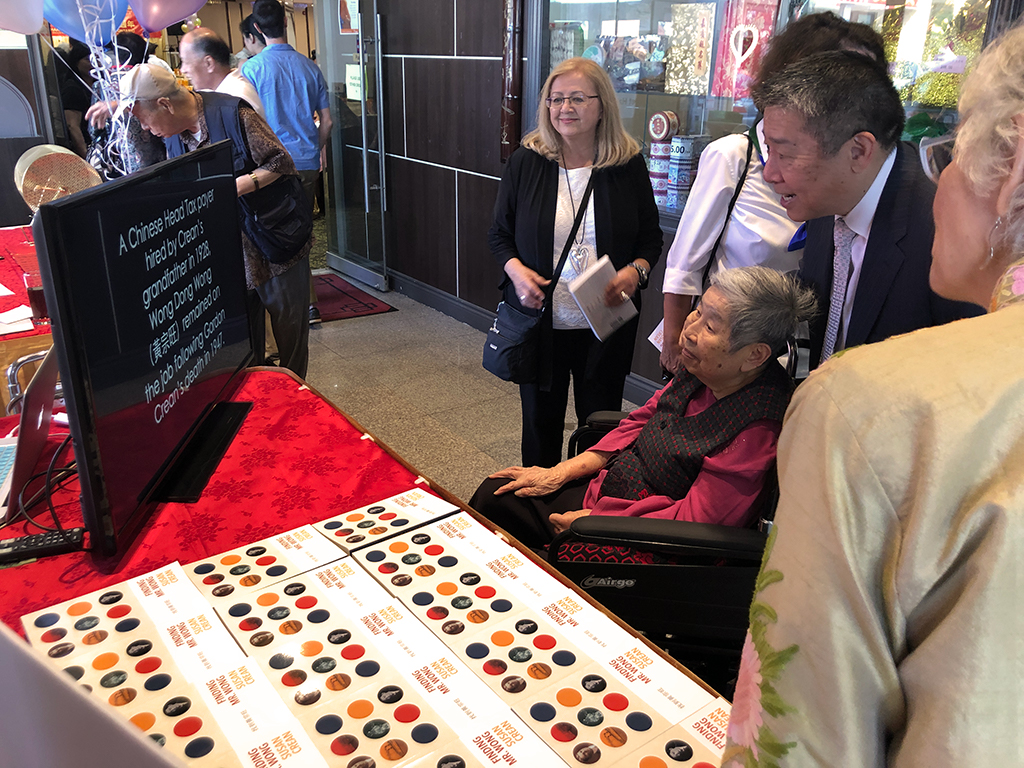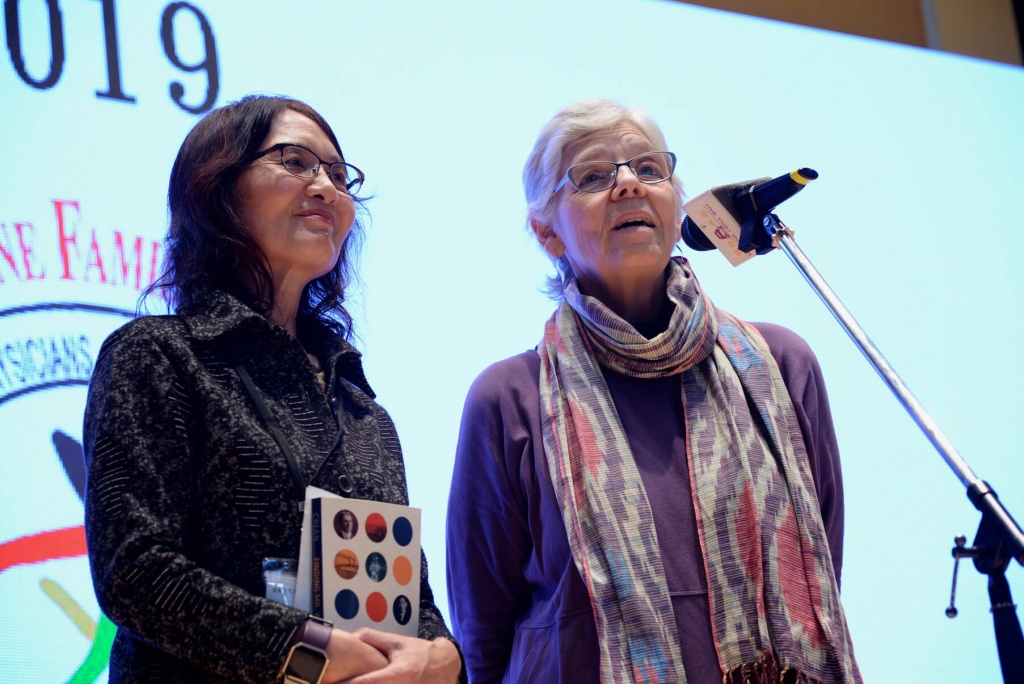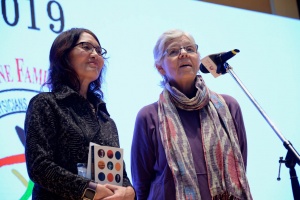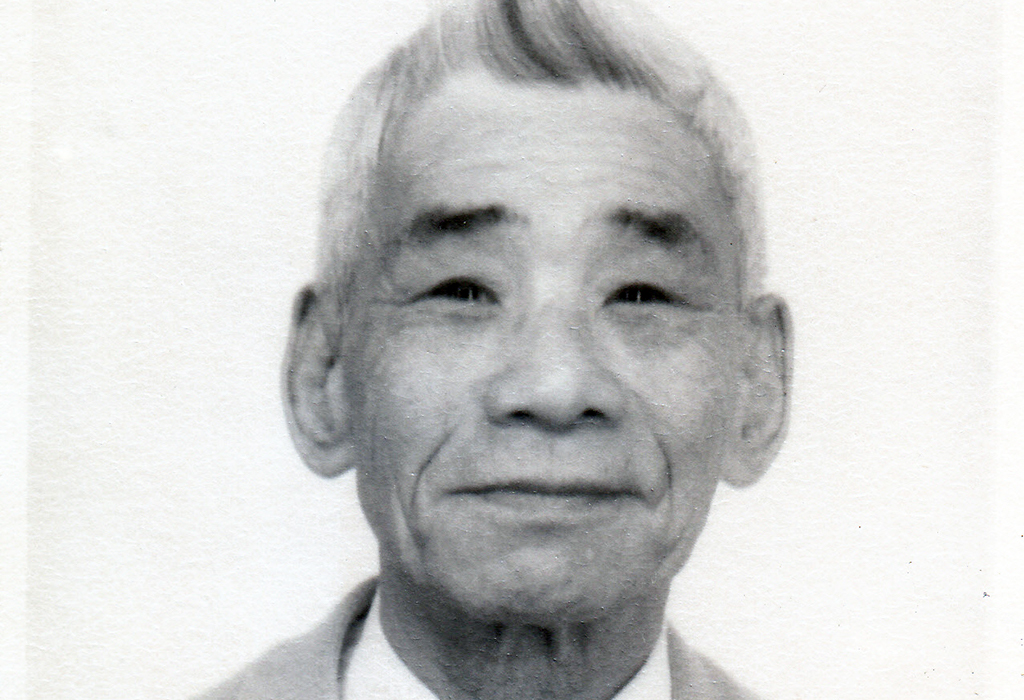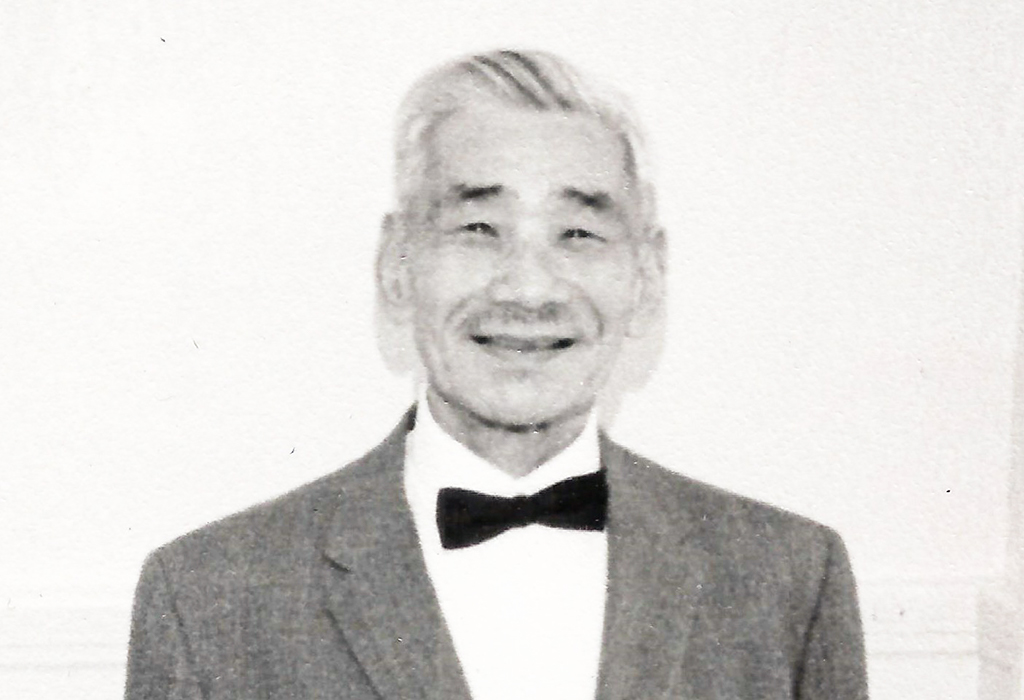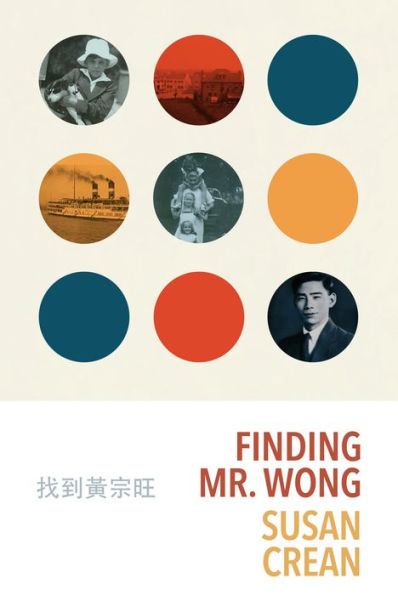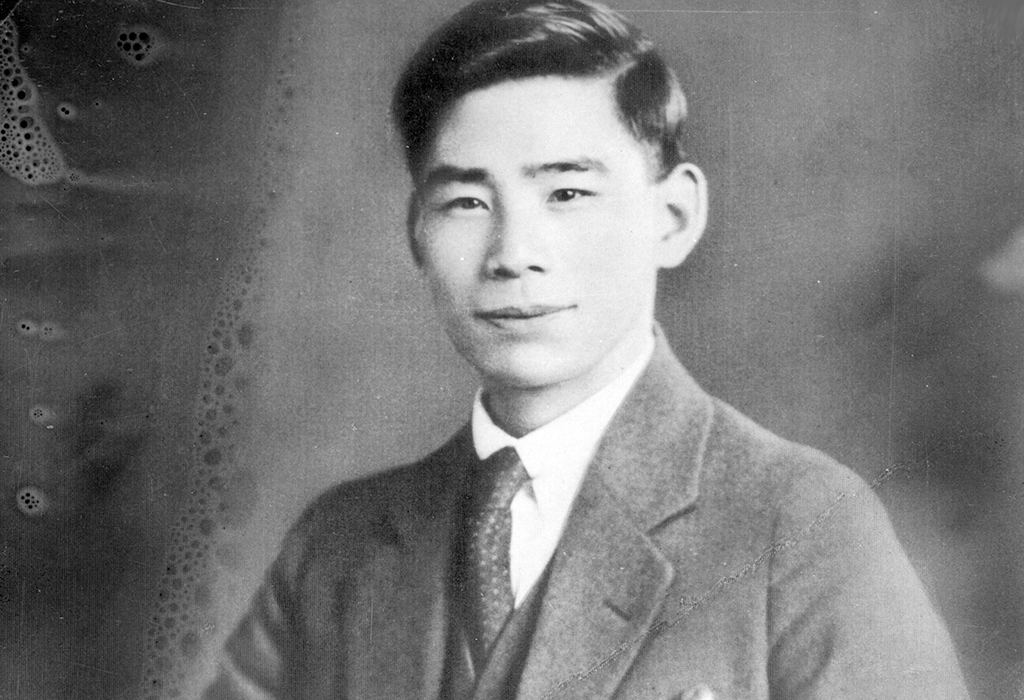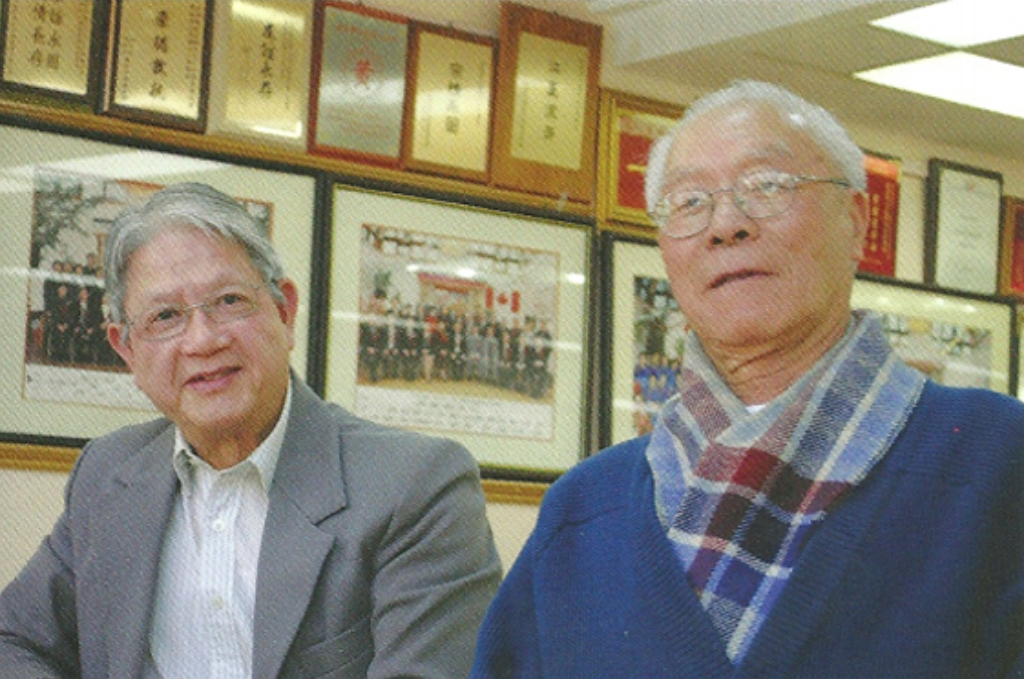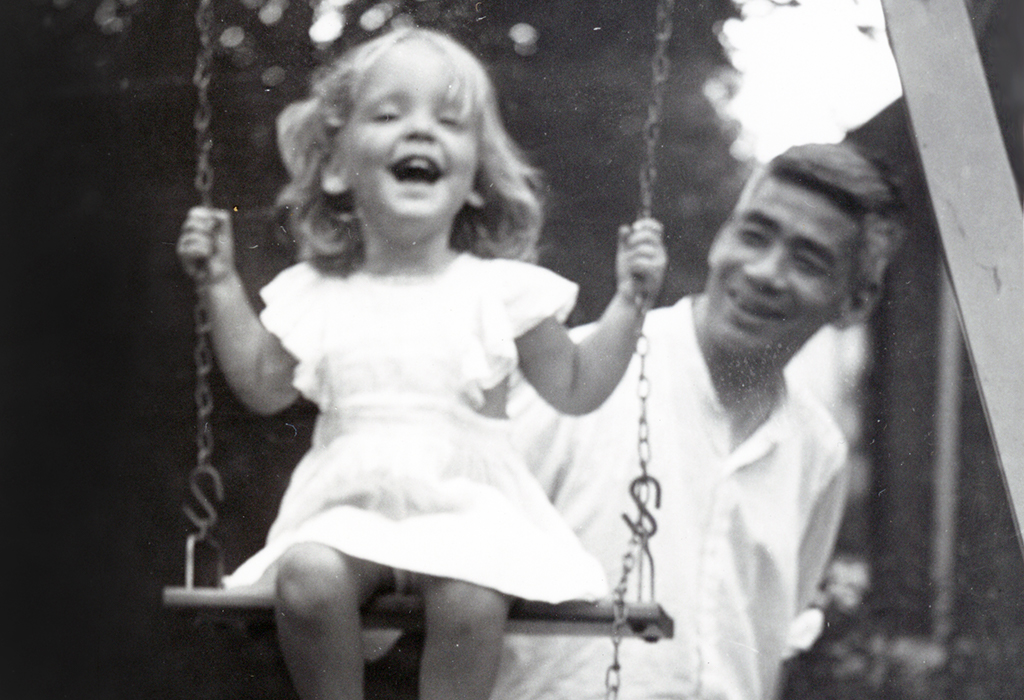Shan Qiao and I have been attending the annual banquet of the Wongs' Association of Ontario (Wong Kung Har Wun Sun) for many years now. It takes place in the Summer. We also frequently participate in the Christmas gathering in December. This year it was held at the Dim Sum King on Dundas Street West in downtown Toronto on December 28th. We were the guests of Chuck K. Wong, and were delighted to attend with Chuck C.C. Wong and his wife Margaret, as well as Chuck K Wong, his wife Libby Wong, and son Brian.
AT THE WONGS’ ASSOCIATION BANQUET
ASIAN CANADIAN HERITAGE MONTH EVENT: Q & A WITH SUSAN CREAN
THE TIES BETWEEN A HOUSE BOY AND HIS EMPLOYER
A tale of A Simple Life in Canada
A white female writer’s search in Taishan
A tribute to her servant’s unfinished dream
This piece by Lu Wong, who reports from Vancouver for Sing Tao, appeared in Sing Tao Daily on September 18th, 2010. You can also download it as a PDF (3.2 Mb). This translation is by Shan (Joanna) Qiao and is part of a series of Chinese head tax stories.
A tale of a man much like the one depicted in Hong Kong’s award-winning movie A Simple Life is happening here in Canada. Former Chair of The Writer’s Union of Canada Susan Crean started her trip to Taishan, China last year in search of the untold story of Wong Chong Wong, her family servant for 37 years.
Susan went to Yong Ning Village, Taishan, Guangdong province last September, hoping to meet with Wong’s descendants, find his family genealogy and learn his past as an orphan.
The relationship of Susan and Wong was as close as a family. She took care of Wong before he passed away a true reflection of the award-winning Hong Kong movie A Simple Life.
Susan says she will continue to search and collect Wong’s information and start to write stories of people like him and other family servants in Canada. She wants to unfold the hardship of Chinese labourers who came to Canada more than a century ago.
Serving the Crean family for four generations
67-year-old Susan is an acclaimed Canadian writer. She remembers that Wong was 50 years old when she was born. In her memory, Wong was no different than her family members.
Originally from Canton province, China, Wong paid the Chinese head tax and came to Canada in 1911. With the help from his uncle Ru Wen Wong, he started working in Vancouver. He came to Toronto in 1917 and was hired by Susan’s grandfather in 1928. Wong started his lifelong work as a servant in Susan’s family then. He passed away in 1970 at the age of 75.
Last September when Sing Tao first told the story of Susan and Wong, many of our readers contacted Susan and provided her with useful information related to Wong and his family.
With the help from several Chinese Canadian history researchers and Vancouver friend Hou Ji Chen (Howe Chan), Susan started her trip to Wong’s birth place, a village called Yong Nian in Taishan. The only official documents identified Wong that Susan has were a piece of immigration paper issued by Canada government and the registration paper Chinese government issued to overseas Chinese in 1940.
Chinese head tax stories: Looking for the descendants in Canton Province
With the village head Jinhua Huang’s help, Susan learned that Wong’s father were died before he was born. His mother passed away two years after. Being an orphan, Wong was under the care of his uncle Ru Yun Wong and eventually followed his uncle’s footstep to Vancouver in 1911.
Wong went to Toronto in 1917. He met Susan’s grandfather and worked as cook and servant since then.
During her stay in Canton, Susan also visited the grandson of Wong’s uncle, Wen Xi Wong. With the help from Wong’s descendants and Hou Ji Chen, she found the genealogy book of Yong Nian village and Wong’s family.
On the genealogy book, it showed the name of Wong’s father as Ru Zhen Wong. Followed that line was the name of Wong, yet replaced by the character “和(he)”.
Looking at the old house Wong used to live, Susan was glad that she was able to pay the last tribute to Wong. With more stories of Chinese domestic workers to be heard, she will continue her research on this particular history of Chinese Canadian.
Sidebar I: Wealthy white family hired houseboy
According to writer Susan’s research, there were many Chinese flocked to Vancouver to build Canadian Pacific Railway between 1881 and 1885. They also created a new local industry, domestic servants. Discriminated by white people, they were generally called “Chinamen” or “houseboy”.
Most of the house servants came to Canada or America in their teenage ages. Not understanding any English, they were introduced to work at white families as cook helper, then they learned laundry, ironing, gardening and babysitting gradually at work. They managed to save some money from the meager earnings and sent back to their families in China.
Normally only wealthy families were able to hire houseboys in Canada. Hence this is one way to show the status of the family at that time. If the houseboy works well, he would be promoted from seasonal helper to a family servant that worked like a butler who takes responsibility to run the family.
Some family servants carefully saved their earnings and opened a restaurant or laundry store after they retired.
Sidebar II
Directed by Ann Hui, A Simple Life is an award-winning Hong Kong movie starring Andy Lau and Deanie Ip. Ah Tao is a family servant and nanny who started working for the Leung family when she was 13 years old. Six decades passed, she has served five generations. As time goes by, some family members passed away and some immigrated. She lives with Roger, the son and the only family members of the Leung.
Although two of them rarely talk, they enjoy the company of each other. One day Ah Tao unexpectedly suffers a stroke, Roger has to send her to senior house for more care. The strong relationship between the employer and his servant is slowly unveiled.
The movie was nominated for the Best Movie at the 68th Venice Film Festival in 2011. Deanie Ip won Best Actress at the Festival and has become the first Hong Kong actress who won the award.
Sidebar III: Remembered as a grandfather
Although discrimination against Chinese people was normal at the time when Susan grew up, she looked at Wong as one of her family members and asked him to be in her family photos. Whenever Susan misses Wong, she would take out the family photo to reminisce him.
“I literally grew up in Wong’s kitchen. He was like my grandfather and I enjoyed his company very much,” says Susan.
She remembers Wong was always around when she was little and let her ride on his shoulders. She even respected Wong as her grandfather and was never shy to show her fondness and curiosity to Wong.
Susan says that Wong cooked excellent food for the family and were good at making both western food and Chinese food. His bicycle repair skills were quite well known in the neighbourhood. It was impressive to her that Wong was the type that never hesitates to offer help whenever needed.
Wong retired in 1964 and moved out to Chinatown. Susan and her sister Jennie visited him frequently.
“It was such a regret that the last time I talked to him was actually through a phone call. I regret that I was not able to see him when he died. I’ll always remember him like my grandfather,” says Susan.
“FINDING MR. WONG: A TALE FROM CANADA’S EXCLUSION ERA” IN NEW CANADIAN MEDIA
MR. WONG’S STORY: A TALE OF SACRIFICE AND GENEROSITY
This article was originally published in The Toronto Star on January 26, 2011 as part of a special supplement celebrating the Chinese New Year. It’s the story of Wong Dong Wong who came to Canada as a teenager in 1911 to work in his uncle’s restaurant in Vancouver. He was an orphan with no future in China but he made one for himself in Canada, migrating East to Toronto in 1917 to work as a domestic cook during the time of the Chinese Exclusion Act in Canada. He was hired by my grandfather in 1928. You can download a PDF version of the piece (78Kb).
I was probably a couple of days old when I first met Wong Dong Wong. From then on he was part of my life, someone I was always in touch with and saw regularly until he died 25 years later. My earliest memories include him, and, throughout my childhood, he was a source of unending magic.

Example: The drawer in the kitchen mysteriously stocked with contraband goods — comics, candy and chewing gum. Example: The May 24 fireworks extravaganza he put on in the back garden attracting half the neighbourhood, the crowd expanding each year until the Forest Hill Police dropped by to investigate.
He could mend bikes, do string games and make ice cream; he played gymnastics endlessly with us in the back yard, and he took me to see my first movie.
He could save your bacon by fishing articles out of the storm sewer lost in games of sink-the-battleship in the gutter after a rainfall; but he could also make you shrivel up smaller than Alice-in-Wonderland when your behaviour crossed the line and he issued a summons to the kitchen.
The other side of this idyll, and the reason for Mr. Wong’s presence in our lives, was anything but pleasant. It was the overtly racist immigration laws of the time, specifically the Chinese Exclusion Act in Canada, which condemned thousands of Chinese men to lives of social isolation and targeted injustice in Canada.
Separated from family, often too poor to return to China despite a lifetime of labour, they ended their days, alone in rooming houses.
Mr. Wong paid a $500 Head Tax to enter Canada in November 1911.
He was 16, although immigration officials at the port of Victoria decided he was 11, and entered that age in the ledger noting he was 4′ 9” in height and had a scar over his left eye.
He was born in Taishan (Toisan) county in Guangdong in 1895, and brought to Canada as a teenager by a relative who had a job waiting for him in Vancouver.
By 1917, he’d acquired facility in Cantonese as well as English, and had mastered the basics of Canadian (English) cooking. Quite probably he’d also repaid his debt. He then moved to Toronto and found work as a domestic cook which meant fulltime, live-in employment in the homes of white people. He was working for a family in Rosedale when he met my grandfather in the late 1920s.
I began researching Mr. Wong’s life two years ago, using his C.I. 36 certificate to locate him in government records.
Always in my mind, though, was his village in China.
I remember talk about his making the journey home, but it was 1965 before he retired, and he was not in good health. He had worked for my grandparents, latterly my widowed grandmother, for 37 years, and was a great deal more than a cook. He ran the household which included cleaning, laundry and gardening as well as cooking, and when my grandmother reached her 80s and 90s, he was a companion to her.
Undoubtedly Mr. Wong worked longer than he should have.
He stayed because of a promise to my grandfather, and, I suspect, because the Canadian government’s refusal to accept his correct date of birth meant old age benefits were delayed until he was 70. His last years were spent in a rooming house in Chinatown, but not alone. He became close to his neighbour Jim Wong, whom he considered a son. (It was Jim who held Wong’s photo at his funeral in 1970).
When I saw Jim’s son, Tao Wong, recently we shared memories of weekly visits to see grandfather Wong: Tao’s family went on Sundays, my sister Jennie and I on Wednesdays. For 40 years, both families have visited Mr. Wong’s grave.
Wong Dong Wong never returned to China. Almost 100 years after his voyage to Canada, I found myself preparing to make the journey “back” myself.
To write about him, I needed to see his homeland, to experience firsthand, as a friend said, “the richness that must have haunted the memories of Mr. Wong when he looked about his Canadian landscape, and, surely, longed for home.”
I knew I might never find his village, much less the story of how and why he left. Yet, six months into the project, my collaborator in China, Smile Leung, located Wing Ning village, and, last Fall, we travelled there together.
Smile and I met first with the Village Head, Wong Jinhua, who told us we would not find Wong Dong Wong in the official genealogy. Wong was an orphan, whose father had died the month he was born and his mother two years later. His uncle, Wong Wanshen, had felt sympathy for the boy, and so arranged for him to go to Canada. There were no prospects for him in China.
Wong Jinhua introduced us to Wong Wenxi and his family, the descendants of Wong Wanshen. They retold the story of Wong Dong Wong, and showed me a photo of Wong Wanshen, as well as the family’s hand-bound, hand-written record of births going back to 1875.
And there it was, the entry “Wong Zongwong born late in the evening, August 28th, 1895.”
If I make this search sound simple, it wasn’t. I succeeded only because of friends, and the generosity of the Taishanese community, not to mention the perfect strangers who contacted me after an article appeared in Sing Tao daily — Taishan County’s Overseas Chinese Affairs Bureau included.
Christmas is the time my family most remember Mr. Wong. We bake his shortbread, improved, I think, by the encounter with his Chinese savoir-fare.
Over the years, Chinese New Year’s has come to mean something, too. Living next to the Seto family in South Riverdale for 20 years, it was Wong’s Scottish shortbread for Mrs. Seto’s dumplings at the beginning of each lunar year. In Vancouver, a few years ago, it was Todd Wong’s combination Robbie Burns’ Day/Chinese New Year banquet Gung Haggis Fat Choy.
New Year’s for me this year is a time to celebrate the remarkable Mr. Wong.
Susan Crean is a Toronto writer and recipient of a Chalmers Arts Fellowship, which made the trip to Taishan possible. More of Mr. Wong’s story can be found on her website: www.whatistoronto.ca
LOOKING FOR WONG DONG WONG
This piece was published in Tai Shan magazine in November, 2010 as part of story about Chinese Canadian history, a scan of which you can download as a PDF (2.3Mb).
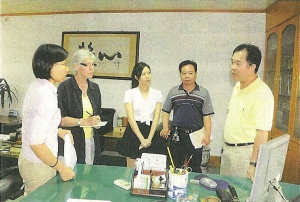
This version, in Chinese includes a photo of our meeting. [On the left Liang Xiaomei (my assistant and interpreter), myself, Cheri the officer who contacted us, the editor of Taishan Xing Ning and director Chen Yao Hong.]
I am a Canadian writer of Scottish and Irish descent. Two years ago I began work on a book which will include the story of a Chinese Canadian, Wong Dong Wong, who was born in Taishan, and came to Canada as a boy of 16 in 1911. In 1917, he relocated from Vancouver on Canada’s West coast to Toronto, and by the late 1920s when he met my grandfather he was working as a domestic cook. In 1928 he came to work for my grandparents and stayed for 37 years. He retired to Chinatown in 1965, and died there in 1970 having never — so far as my family knew, returned to China.
Tracing Mr. Wong’s Story
All this time later, I started tracing Mr. Wong’s story, dreaming that I perhaps would succeed in finding his village. I knew it was in Tai Shan, but I very little about his origins; the family stories varied on the subject of a wife or children. He was very private, but when I was little he told me about being an orphan, and how once he’d lost his way in the fog while tending his uncle’s cow. He’d been terribly afraid, but the cow knew her way, and guided him back home through the night.
I began with the documents he left, which fortunately included one identity card issued in the early 1940, and largely in Chinese. Thus I was able to locate his ancestral village — Wing Ning. I planned the trip over a year, but just before I left for China last September, a story about my search was featured in the local Sing Tao.
This brought a lot of calls and emails by people who were touched by the story. Several offered help, and more than one family contacted relatives in Taishan. The list included the County Bureau for Foreign and Overseas Chinese Affairs which contacted me before I’d left Beijing for Taishan!
Arriving at the Village
We met first with the Village head, Wong Jinhua, in the office of Zhen Changmin Overseas Affairs director for S’anhe County. This was the first of three meetings with Mr. Wong who was generous with his time, and in helping me meet people in the village. Director Chen Yao Hong and his staff in the FOC Affairs Bureau had researched what they could in advance, and offered continued support. I was travelling with an assistant and interpreter, but several of Bureau staff speak excellent English. We were included in the dinner being given that evening to honour Albert Chen, the founder of the Chinese Culture Foundation of San Francisco, by deputy mayor Suzanna Huang. (And it happened to be the birthday of them both!)
We were welcomed in the village. Our arrival was not secret. We visited Wing Ning twice, and spent time there with elder Wong Wenxi who is a grandson of Wong Wanshen, the man responsible for bringing Wong Dong Wong to Canada. Wong Wenxi was six when his grandfather returned from Canada in the mid 1930s, and knew the story of Wong Dong Wong whose father died just before he was born. Wong Wanshen adopted the boy, and from papers the family still have relating to Wong Wanshen’s life in Canada, it seems likely he’d arranged a job for young Wong upon his arrival in Vancouver.
Meeting Mr. Wong’s Family
We met the sons and daughters, and grandchildren of Wong Wanshen’s grandson who showed us around the village and pointed out the landmarks. We met with the oldest resident, now in has 90s who remembers Wong Wanshen as a man of means when he returned, a man who looked after many things in the village.
The trip was a terrific success. I found Mr Wong’s story and met the descendants of his kin. This only happened because people found a reflection of other stories they know about and are connected to in Mr. Wong’s life. These are the stories of the Head Tax generation, an era of Chinese Canadian history when young men were condemned by Canadian Exclusion Laws to a lifetime of relentless work and solitude in Canada. Like Wong Dong Wong their lives were invisible to history during his lifetime, but their enormous contribution to Canadian life is finally becoming known.
Reference: The story of Chinese Canadian pioneers can be found at http://www.mhso.ca/tiesthatbind/ which documents the contribution of the original immigrants from Guangdong to Canada who built the critical last section of the TransCanada railroad through the Rocky Mountains to the coast.
VISITING THE WONGS’ ASSOCIATION
This article was originally published in the Wongs’ Association Convention magazine in 2011 as part of an exploration of Chinese in Canada history. You can also download the article as a PDF (2.3Mb).
Climbing the narrow staircase to the Wongs’ Association’s third floor office in downtown Toronto, past the plaque reading Wong Kung Har Wun Sun Association in Chinese and English, you reach a nondescript door that gives no hint of what lies beyond. When the association bought the building in 1979 the entire top floor was redesigned and the space opened up. Along with offices and a small kitchen, it now accommodates a large assembly hall with a 20′ ceiling where the shrine to the Wong ancestors stands in gilded solemnity, lit from above by large windows encircling the raised roof — itself a first in the neighbourhood. So, past the door you walk into a burst of natural light — even on a rainy day.
Arriving at the Wong’s Association
Tuesday afternoon at the end of March might seem an unlikely time to find anyone at here, but my visit is at the invitation of Chuck K. Wong, a director of the Association for more than a decade. He is on duty today, one of a roster of volunteers who make sure “there’s always someone here to let members in.”
He shows me around, pointing to the Wong family tree and the photographs of Association members that line the hallway, and the place of honour inside the Hall for the photos of the Association chairmen going back to the 1950s.
A Tase of Chinese Canadian History
He relates the story of the ancestor commemorated here (one of 21 sons of the original patriarch) and gives me a thumbnail sketch of the history of the Association and its two antecedent organizations. The original members were Toishanese, and given the small Chinese community living in Toronto during the Exclusion years (1923-47), their numbers dwindled. “To strengthen the association we needed more members, so other Wongs were invited to join us,” he explains.
His knowledge, he tells me, comes largely from conversations; what he knows is what elders have told him over the years. So he worries about losing these memories before the history of the Association has been properly recorded.
What’s on Chuck K. Wong’s mind, though, is not the past but the up-coming tri-annual national convention which will bring Wongs from around the world to Toronto for three days in August. He sees the event as an opportunity for re-engagement.
An International Gathering
The international dimension of the clan’s experience is a key part of the Wong heritage. Emigration has produced an astonishing diversity in the name itself, he notes. It has also, obviously, nurtured a skill for negotiating cultures, not to mention foreign languages and customs. Two characteristics seem to be key. First the tendency of Toishanese to treat each other as family, and to believe in the ethic of helping one’s own and sharing resources.
So, from the beginning the community reached beyond the Chinatowns across the country into small towns and remote places like Moose Factory creating a web of relationships built up between relatives and friends that enabled people to survive.
Secondly, there was the clan’s reputation for honouring its word. The Association, for example, set up a committee which operated like a credit union, providing seed money for members when no bank would. “There was nothing on paper. It was all on people’s word, ” Mr. Wong emphasizes repeating the old adage: “When you deal with a Wong, nothing can go wrong.”
A Valuable Community
Mr. Wong was himself inspired by his great uncle Wong Nan Yao, the third chairman of the Wong Kung Har Wun Sun Association who first took him to the Association, and who always spoke of the importance of contributing to the community, and giving back. Times change, and today the Association may no longer be the social and economic lifeline it was, but the value of community has not disappeared.
A week later, on a Saturday afternoon, we pull up to Greg K.W. Wong’s house and find him working in the garden, eagerly making up for the long delay of Spring. He is part of the convention committee whose work is well underway at this point.
We chat in his spacious kitchen, my friend Chuck C.C. Wong, who brought me along, has taken on the task of putting the convention booklet together. Greg K.W. Wong regularly hosts sessions like this at his house — and very soon in his back garden, too — and clearly knows a lot of people. He recruits individuals who want to make something happen, and charges them with doing just that.
An affable man, he welcomes participation and delegates decision-making. So the cast of volunteers gathers numbers like a chain letter.
Greg K. W. Wong also sees history as instructive. However, there will be no dwelling on the past at the convention. “The intention is to encourage young people to ask themselves what they’d like to achieve, not to encourage them to carry chips on their shoulders.” Like Chuck C.C. Wong, he worries about the history that is locked up in memory, including those stories never spoken of. And he also speaks of the necessity of collaborative action.
He tells the story of how during the Exclusion years, when racism was virulent and the Chinese were barred from public places like trains, hotels and swimming pools, people would travel from Chinatown to Chinatown via an “underground railroad” of safe houses. This was how the community worked, looking after its own. And to this day, if you stop of at a local Chinese restaurant you are likely to be greeted as family.
The power of association has to do with numbers, but it also has to do with the sharing skills and knowledge. It can be a source of individual self-knowledge, and self-confidence. “Given the history of the Wongs in Canada, and our contributions to the country, to be a Wong today means being equal to all and second to none.”

